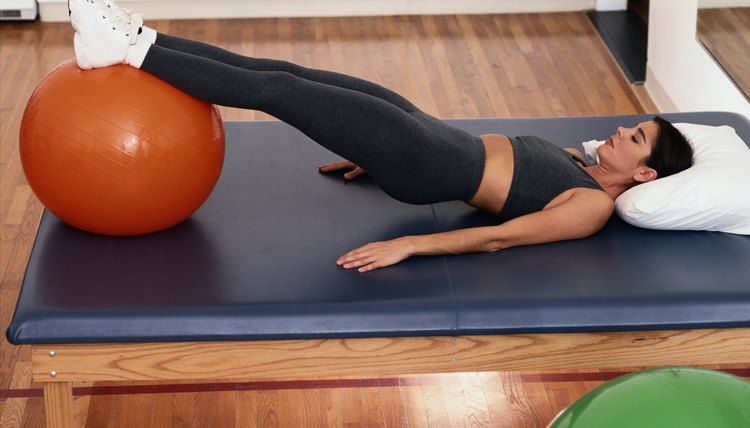Muscles Worked in Bridge Pose Exercises

The bridge is a strength exercise for your core muscles. It involves lifting your hips off the floor and holding this pose for a one count or more. You do not need any extra equipment for the bridge exercise, but you can use balance equipment to make it more challenging.
Execution
To do the basic bridge pose, lie on your back with your knees bent and your feet flat on the floor about hip-width apart. Relax your arms next to your sides. Exhale and lift your hips off the floor until your body is a straight line from your knees to your shoulders. Your hamstrings and gluteus muscles are the main movers as you lift your hips off the floor. Squeeze your buttocks and pull your belly button toward your spine to activate your abdominal muscles. Hold this pose for a one count and lower your hips back to the floor.
Function
The bridge exercise targets your core muscles, which includes your abdominal muscles -- rectus abdominis and transverse abdominis -- and your low back and gluteus muscles. In addition to your core muscles, the bridge exercise works your hamstrings, the muscles on the back of your thighs. Some bridge exercise variations also target your quadriceps, the muscles on the front of your thighs.
Variations
After you lift your hips off the floor, extend one leg into the air for a count. This engages the quadriceps muscles and enhances the balance challenge. The more difficult the balance challenge is, the harder your abdominal and low back muscles work to stabilize your body in the bridge pose. You can also place your feet on an unstable surface, such as a stability ball, to increase the balance challenge.
Hold one leg tucked in to your chest to do a single-leg bridge exercise. This increases the work of your hamstring muscles since only one leg is pressing your entire torso. Performing a single-leg bridge on a stability ball is an advanced bridge exercise that requires high levels of strength, balance and flexibility.
Considerations
When you lift your hips, do not lift them so high that your back arches. Keep your body in a straight line. Engaging your glute muscles relieves some of the tension from your lower back muscles.
Perform the bridge as a continuous movement, or hold the pose for extended periods of five seconds or more. Your abdominal muscles and low back muscles isometrically contract -- contract without significant movement -- to hold your hips up in the bridge pose. Remember to keep breathing normally if you hold the pose for an extended period.
Explore In Depth
References
- American Council on Exercise: Stability Ball Shoulder (Glute) Bridge
- American Council on Exercise: Glute Bridge Single Leg Progression
- Lehecka BJ, Edwards M, Haverkamp R, et al. Building A Better Gluteal Bridge: Electromyographic Analysis Of Hip Muscle Activity During Modified Single-leg Bridges. Int J Sports Phys Ther. 2017;12(4):543-549.
Writer Bio
Based in Austin, Texas, Jolie Johnson has been in the fitness industry for over 12 years and has been writing fitness-related articles since 2008 for various websites. She received her Bachelor of Arts in English and philosophy from the University of Illinois.
